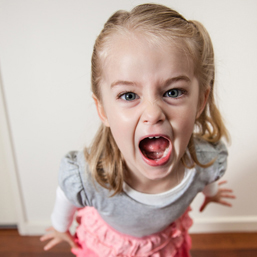
Does your child throw temper tantrums when things don’t go their way? Does your child hit their sibling(s) when they are mad? Does your child throw their toys across the room when they are frustrated? Often, kids don’t understand how to appropriately express strong feelings like anger, frustration, or disappointment, causing them to act out. This is totally normal. And the good news is, you can help your child understand their emotions, express themself in a healthy way, and learn how to cope with their feelings.
Teach feeling words. The biggest obstacle toddlers have when expressing their feelings is the simple fact that they do not have the words to explain what is going on. For example, when your child has worked hard to build a tower of blocks only to have it topple over, they may feel frustrated. Saying to your toddler, “You are frustrated with your blocks, aren’t you? Can I help you?” acknowledges your toddler’s feelings and gives them the words to identify feelings of frustration in the future. Or if a sibling took their toy away and your toddler begins to cry, acknowledge that they are sad and come up with a solution together to work it out.
In the future, give your child the opportunity to express how they are feeling and listen to them. This will help them show their feelings through words rather than actions (like hitting or throwing a tantrum). For an older child, ask them what they are feeling and listen to their answer without criticism. If they are having trouble coming up with feeling words to express themself, give them a couple of feeling words that you feel may best describe the situation. Ask them if they feel there is a better way they can handle the situation at hand and talk it out together.
Talk often about feelings. It is important not only to give your child the words to express their feelings but also to notice and label the feelings of others. For example, when you arrive home to your dog that greets you at the door with a wagging tail, explain to your child that the dog is excited to see you. Or if they notice someone else crying, talk to them about how people can be sad and why. If your child acts out toward someone else, try to explain the feelings involved, “You were mad at your sister and so you told her you didn’t like her anymore. That hurt her feelings and now she feels sad.” Help your child to notice the cues and body language of others and guess their emotions. You can also play a game where you make faces at each other and then identify the correct emotion. First, make a happy face, then a mad face, and then a sad face. As you read books to your child, have them guess the feelings of the characters.
Model appropriate expression. It’s okay for your child to know that you too have feelings of sadness, excitement, frustration, and anger just like they do. During these heated emotional moments, you can model a positive way of dealing with your feelings to your child. For example, when you get mad, you have the opportunity to yell or you can calmly say to your family that you need to take a walk and excuse yourself, so you can cool down. When you are frustrated with a task, let your child know what you are feeling and that you have decided to take a break or ask for help. Feelings of sadness are normal, and you can show your kid that it’s okay to feel down. Spending time with the people you care about, exercising, or doing something you enjoy is a great way to lift sadness.
Teach appropriate ways to deal with emotions. Once your child can express how they feel using words, you can help them come up with appropriate ways to express their feelings. For some kids, this may be talking about their feelings. For other kids, they may need extra snuggles or hugs from you. For another child, having time to be alone to sort out their thoughts and feelings or cool down gives them the time they need to process their emotions, so they can discuss them. For example, when my daughter gets mad, she finds it helpful to go to her room, shut the door, and turn up the music. I often hear her singing as she looks at books, plays, or even cleans. When she joins the family again she is calmer, happier, and able to talk and interact calmly. My son prefers to take a walk when he is upset; the exercise and fresh air helps him settle down. Depending on the child, their current emotion, and the situation, coping skills may look very different.
As your child begins to learn to express their feelings using words and appropriate coping skills, it is important to give them positive feedback. This will help encourage them to continue to express themself as they mature.
Sarah is a wife, and a mother of six children.
Calgary’s Child Magazine © 2024 Calgary’s Child